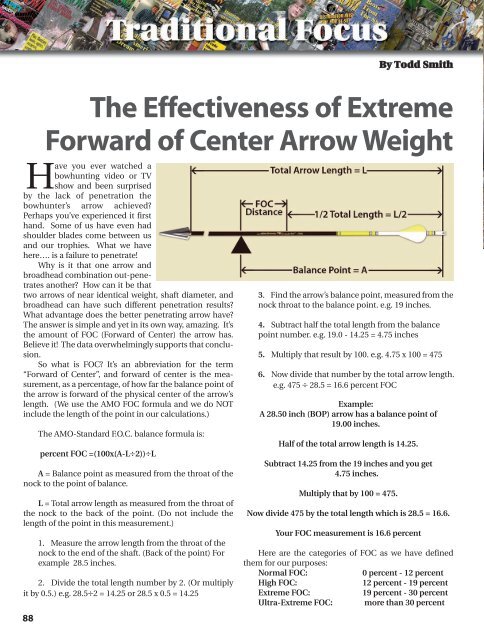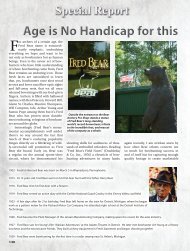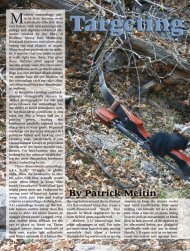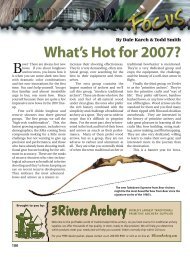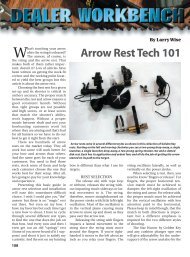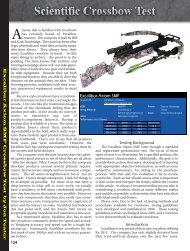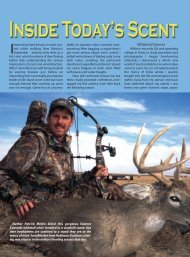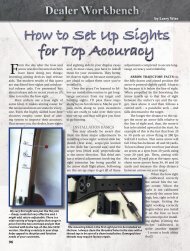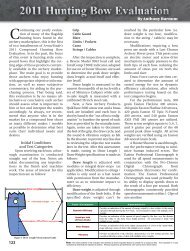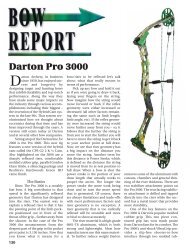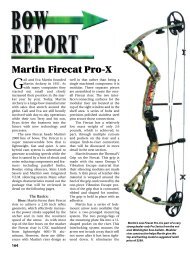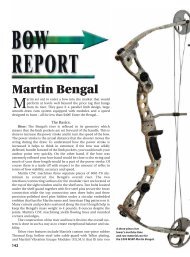The Effectiveness of Extreme Forward of Center - Arrow Trade ...
The Effectiveness of Extreme Forward of Center - Arrow Trade ...
The Effectiveness of Extreme Forward of Center - Arrow Trade ...
Create successful ePaper yourself
Turn your PDF publications into a flip-book with our unique Google optimized e-Paper software.
Have you ever watched a<br />
bowhunting video or TV<br />
show and been surprised<br />
by the lack <strong>of</strong> penetration the<br />
bowhunter’s arrow achieved?<br />
Perhaps you’ve experienced it first<br />
hand. Some <strong>of</strong> us have even had<br />
shoulder blades come between us<br />
and our trophies. What we have<br />
here…. is a failure to penetrate!<br />
Why is it that one arrow and<br />
broadhead combination out-penetrates<br />
another? How can it be that<br />
two arrows <strong>of</strong> near identical weight, shaft diameter, and<br />
broadhead can have such different penetration results?<br />
What advantage does the better penetrating arrow have?<br />
<strong>The</strong> answer is simple and yet in its own way, amazing. It’s<br />
the amount <strong>of</strong> FOC (<strong>Forward</strong> <strong>of</strong> <strong>Center</strong>) the arrow has.<br />
Believe it! <strong>The</strong> data overwhelmingly supports that conclusion.<br />
So what is FOC? It’s an abbreviation for the term<br />
“<strong>Forward</strong> <strong>of</strong> <strong>Center</strong>”, and forward <strong>of</strong> center is the measurement,<br />
as a percentage, <strong>of</strong> how far the balance point <strong>of</strong><br />
the arrow is forward <strong>of</strong> the physical center <strong>of</strong> the arrow’s<br />
length. (We use the AMO FOC formula and we do NOT<br />
include the length <strong>of</strong> the point in our calculations.)<br />
88<br />
<strong>The</strong> AMO-Standard F.O.C. balance formula is:<br />
percent FOC =(100x(A-L÷2))÷L<br />
A = Balance point as measured from the throat <strong>of</strong> the<br />
nock to the point <strong>of</strong> balance.<br />
L = Total arrow length as measured from the throat <strong>of</strong><br />
the nock to the back <strong>of</strong> the point. (Do not include the<br />
length <strong>of</strong> the point in this measurement.)<br />
1. Measure the arrow length from the throat <strong>of</strong> the<br />
nock to the end <strong>of</strong> the shaft. (Back <strong>of</strong> the point) For<br />
example 28.5 inches.<br />
2. Divide the total length number by 2. (Or multiply<br />
it by 0.5.) e.g. 28.5÷2 = 14.25 or 28.5 x 0.5 = 14.25<br />
3. Find the arrow’s balance point, measured from the<br />
nock throat to the balance point. e.g. 19 inches.<br />
4. Subtract half the total length from the balance<br />
point number. e.g. 19.0 - 14.25 = 4.75 inches<br />
5. Multiply that result by 100. e.g. 4.75 x 100 = 475<br />
6. Now divide that number by the total arrow length.<br />
e.g. 475 ÷ 28.5 = 16.6 percent FOC<br />
Example:<br />
A 28.50 inch (BOP) arrow has a balance point <strong>of</strong><br />
19.00 inches.<br />
Half <strong>of</strong> the total arrow length is 14.25.<br />
Subtract 14.25 from the 19 inches and you get<br />
4.75 inches.<br />
Multiply that by 100 = 475.<br />
By Todd Smith<br />
<strong>The</strong> <strong>Effectiveness</strong> <strong>of</strong> <strong>Extreme</strong><br />
<strong>Forward</strong> <strong>of</strong> <strong>Center</strong> <strong>Arrow</strong> Weight<br />
Now divide 475 by the total length which is 28.5 = 16.6.<br />
Your FOC measurement is 16.6 percent<br />
Here are the categories <strong>of</strong> FOC as we have defined<br />
them for our purposes:<br />
Normal FOC: 0 percent - 12 percent<br />
High FOC: 12 percent - 19 percent<br />
<strong>Extreme</strong> FOC: 19 percent - 30 percent<br />
Ultra-<strong>Extreme</strong> FOC: more than 30 percent
Dr. Ed Ashby with one <strong>of</strong> his test subjects.<br />
When you look at the FOC image to the left, it’s easier<br />
to understand some <strong>of</strong> the benefits <strong>of</strong> higher percentages<br />
<strong>of</strong> FOC if you think <strong>of</strong> the arrow and its balance point as<br />
though the arrow were a lever and the balance point a fulcrum.<br />
<strong>The</strong> closer this balance point is to the point, the less<br />
force is needed on the nock end to influence the point<br />
end. Because <strong>of</strong> that, the nock end doesn’t have to work as<br />
hard to guide the point end.<br />
Benefits <strong>of</strong> Higher FOC<br />
1. Because arrows with high FOC inherently stabilize<br />
quicker they rely less on the influence <strong>of</strong> feathers or vanes.<br />
Combine that with the “lever effect” referred to in the previous<br />
paragraph and it becomes evident that much smaller<br />
feathers and vanes can be used, which lightens the<br />
nock end even more.<br />
2. <strong>Arrow</strong>s with high FOC and smaller feathers are less<br />
affected by cross winds than arrows with larger feathers<br />
and less FOC so they drift less.<br />
3. High FOC helps overcome the effects <strong>of</strong> broadhead<br />
steerage.<br />
4. <strong>Arrow</strong>s with high FOC inherently recover faster<br />
from archer’s paradox and retain more energy for flatter<br />
trajectories and more impact force at your target.<br />
About <strong>The</strong> Author<br />
Todd Smith has been a traditional<br />
bowhunter for over 40 years.<br />
After learning the art <strong>of</strong> handcrafting<br />
wood arrows in Alaska from his<br />
mentor John Dodge, he built<br />
arrows pr<strong>of</strong>essionally for several<br />
years. In 2008, after a 19 year stint<br />
with 3Rivers Archery, he made the<br />
decision to help other businesses<br />
grow and currently <strong>of</strong>fers marketing<br />
services through his website<br />
ToddSmithCo.com.<br />
Todd Smith’s Traditional Focus<br />
column in <strong>Arrow</strong><strong>Trade</strong> is being<br />
sponsored in part by Alaska<br />
Bowhunting Supply.<br />
5. High FOC arrows recover faster<br />
from the extra paradox induced by finger<br />
shooters.<br />
6. As stated above, when all else is<br />
equal, the greater the FOC the greater<br />
your tissue penetration will be.<br />
<strong>The</strong> balance <strong>of</strong> this article covers the penetration<br />
advantage mentioned in number 6 above and is based on<br />
the findings <strong>of</strong> Dr. Ed Ashby. Dr. Ashby has been testing<br />
arrow performance and arrow penetration for some 28<br />
years now. His involvement in the Natal broadhead study<br />
in the 1980’s was instrumental in opening the door for<br />
legal bowhunting in Africa. His testing is done in the field,<br />
on live or freshly killed animals. He does not use ballistic<br />
gel or other mediums, then guess at an arrow’s potential<br />
effectiveness on game. He shoots arrows into hide, bone,<br />
and flesh carefully documenting the results. His research<br />
is as scientific as<br />
it can be under<br />
field conditions.<br />
All testing, shots,<br />
equipment, conditions,<br />
and<br />
results are then<br />
shared freely<br />
with the entire<br />
bowhunting<br />
community.<br />
Speaking <strong>of</strong><br />
free… We’d like<br />
Testing with field<br />
points is an inexpensive<br />
way to figure<br />
out what<br />
weight up front<br />
gives you the best<br />
flight and highest<br />
FOC.<br />
89
to state for the record that Dr. Ashby receives<br />
no compensation for any <strong>of</strong> his testing or for<br />
publishing his results. He endorses no commercial<br />
entities. He simply wants to increase<br />
the odds <strong>of</strong> bowhunter success by sharing the<br />
results <strong>of</strong> what works best and what doesn’t<br />
work well on big game. As a result <strong>of</strong><br />
bowhunters hunting with set-ups that take<br />
advantage <strong>of</strong> Dr. Ashby’s findings, there will<br />
be a decrease in the instances <strong>of</strong> animals lost<br />
to poor penetration and/or poor broadhead<br />
performance. Since he receives no payment<br />
for any <strong>of</strong> his work he is free to tell it like it is.<br />
<strong>The</strong>re is no reason for him to attempt to control<br />
any <strong>of</strong> the outcomes. He’s free to search<br />
out and report the truth because he has no<br />
dog in this hunt. We owe Dr. Ashby a debt <strong>of</strong> gratitude for<br />
his selfless contribution to the bowhunting community.<br />
Before we can explore the benefits <strong>of</strong> greater FOC we<br />
need to get our priorities straight. Dr. Ashby defined 12<br />
penetrating enhancing factors during his seminar at the<br />
2010 ATA trade show. <strong>The</strong> first three, in order <strong>of</strong> importance<br />
are: structural integrity, arrow flight, and then EFOC<br />
(<strong>Extreme</strong> <strong>Forward</strong> <strong>of</strong> <strong>Center</strong>).<br />
Structural Integrity: You can have the perfect arrow<br />
with Ultra-<strong>Extreme</strong> FOC flying perfectly but it will not<br />
matter in the least if your broadhead and/or arrow fails<br />
upon impact. If your arrow shaft and/or broadhead fail at<br />
impact, how can there be lethal penetration?<br />
In his testing Dr. Ashby identified a specific list <strong>of</strong> best<br />
<strong>of</strong> breed broadheads that performed well under all conditions.<br />
You can review his reports online for a listing <strong>of</strong><br />
these broadheads. It is important to note that for the data<br />
90<br />
Pat Corrado knows that arrows with EFOC <strong>of</strong> at least 650 grains with the right<br />
broadheads help put big game down even when things go wrong.<br />
we’ve used to make our case for the effectiveness <strong>of</strong> EFOC,<br />
only shots made with arrow and broadhead combinations<br />
that remained structurally intact were included.<br />
Very Important! Dr. Ashby sharpens every broadhead<br />
to razor sharpness before taking the test shots. <strong>The</strong>se are<br />
not, “out <strong>of</strong> the package” broadheads. <strong>The</strong>y are very sharp,<br />
the kind <strong>of</strong> sharp you can feel good about hunting with.<br />
<strong>Arrow</strong> Flight: If your arrow is not flying perfectly when<br />
it reaches the animal, much <strong>of</strong> your energy that could<br />
have contributed to penetration will be lost. Since poor<br />
flight robs so much penetration potential, Dr. Ashby bare<br />
shaft tunes his arrows ahead <strong>of</strong> time to eliminate that<br />
problem. It can be assumed that all shots included in the<br />
testing were flying as perfectly as possible.<br />
EFOC: (<strong>Extreme</strong> <strong>Forward</strong> <strong>of</strong> <strong>Center</strong>)<br />
After all the testing, the data clearly shows that<br />
Keith Jabben <strong>of</strong><br />
Precision<br />
Designed<br />
Products (far left)<br />
<strong>of</strong>fers several<br />
options for boosting<br />
point weight,<br />
including weights<br />
that screw into the<br />
rear <strong>of</strong> specially<br />
designed inserts.<br />
A long tool allows<br />
you to do this<br />
from the nock end<br />
<strong>of</strong> the arrow, without<br />
removing the<br />
insert.
Broadheads in weights from 100 grains to 300+ grains, make it easy to increase your FOC and<br />
maintain perfect arrow flight.<br />
<strong>Extreme</strong> FOC arrows do <strong>of</strong>fer substantial gains in penetration<br />
and that this gain begins at approximately 19 percent<br />
FOC.<br />
To reiterate: That is IF the arrow shaft and broadhead<br />
have the structural strength to remain intact during the<br />
penetration process. If you shoot a broadhead that can’t<br />
get through the bone, it’s not going to matter how well<br />
your arrow is flying, how much kinetic energy, mass<br />
weight, or FOC you have built into your arrow. If your<br />
equipment fails, penetration stops.<br />
<strong>The</strong> penetration benefit <strong>of</strong> EFOC is what we’re primarily<br />
discussing today, but first things first. Dr. Ashby<br />
previously studied and published his reports on the heavy<br />
bone threshold. He shot many sets <strong>of</strong> arrows <strong>of</strong> different<br />
mass weights, from different bows, into the rib section <strong>of</strong><br />
adult Asiatic Buffalo. <strong>The</strong> tests revealed that the magic<br />
number for arrow mass weight for breaching the heavy<br />
bone threshold was approximately 650 grains. <strong>The</strong>se ribs<br />
are big, tough, and quite a challenge for an arrow to penetrate.<br />
Why was that an important discovery? Because it<br />
revealed that many <strong>of</strong> the sub-650 grain arrows failed to<br />
breach the bone, which tells us that if we want to give our<br />
arrows the highest likelihood <strong>of</strong> penetrating an accidental<br />
bone hit, we should use arrows weighing a minimum <strong>of</strong><br />
650 grains.<br />
With ribs that large you might think that 70 pound at<br />
28 inches would be the minimum bow weight to be able to<br />
accomplish the bone breaching. In fact, Dr. Ashby used<br />
an 82 pound at 27 inch longbow. With that bow, 100 per-<br />
PHOTO BELOW: Many compound shooters, like John Horn who is shown on the right<br />
with his guide and an Asiatic Buffalo, are taking advantage <strong>of</strong> arrows with built in<br />
EFOC for all their big game hunting.<br />
Using heavy brass inserts with<br />
accessory weights is another easy<br />
path to higher FOC.<br />
cent <strong>of</strong> all arrows weighing 650 grains or more successfully<br />
penetrated the on-side ribs. However, in the sub-650<br />
grain category a full 50 percent <strong>of</strong> those lighter arrows<br />
failed to penetrate the ribs at all, no matter how much<br />
kinetic energy they carried with them.<br />
<strong>The</strong>re was another test bow, it was a 40 pound at 27<br />
inch recurve. Amazingly the test results were the same as<br />
for the 82 pound bow! Of the arrows over 650 grains, 100<br />
percent breached the heavy bone threshold and likewise<br />
only 50 percent <strong>of</strong> the sub-650 grain arrows breached the<br />
heavy bone threshold. That’s especially impressive when<br />
considering the difference in the kinetic energy transferred<br />
to the arrows by a 40 pound bow as compared to an<br />
82 pound bow.<br />
It took me a while to wrap my brain around that one.<br />
Let’s face it, most bowhunters wouldn’t even hunt whitetail<br />
deer with a 40 pound bow and here it was punching<br />
arrows through the massive rib bones <strong>of</strong> Asiatic Buffalo.<br />
That must be<br />
some bow, right?<br />
Maybe, but it<br />
was the arrow<br />
and broadhead<br />
combinations<br />
that were doing<br />
the punching.<br />
Once the bow<br />
transfers energy<br />
to the arrow, it’s<br />
91
up to the arrow and broadhead from that<br />
point on. That’s why proper arrow and<br />
broadhead selection is crucial to increasing<br />
your odds <strong>of</strong> success on big game.<br />
Now for the real kicker…. the tests<br />
also revealed that no matter which<br />
arrows breached the heavy bone threshold,<br />
arrows with FOC less than 19 percent<br />
stopped shortly after penetrating<br />
the near side rib. Only those arrows with<br />
high percentages <strong>of</strong> FOC routinely continued<br />
penetrating all the way to the<br />
opposite side. In other words, there was<br />
a direct correlation between the amount<br />
<strong>of</strong> FOC and the arrow’s ability to penetrate once the bone<br />
was breached.<br />
So how can you achieve greater FOC ?<br />
· By increasing your point weight. <strong>The</strong>re are field points<br />
and broadheads available from 100 grains to over 300<br />
grains.<br />
· By using inserts that accept auxiliary weights. <strong>The</strong>se<br />
weights screw into the back <strong>of</strong> the inserts and you can<br />
stack as many as you need. Precision Designed<br />
Products is one company that supplies them.<br />
· By using brass inserts instead <strong>of</strong> aluminum inserts.<br />
· By using steel broadhead adapters instead <strong>of</strong> aluminum<br />
broadhead adapters.<br />
· By switching to tapered arrows that have built in FOC.<br />
Alaska Bowhunting Supply’s full length tapered<br />
“GrizzlyStik” arrows and AMG’s GT20 parallel to<br />
tapered carbon arrow are good examples.<br />
Note: Compound bows will benefit from increasing<br />
their FOC as well, but remember that perfect arrow flight<br />
is higher on the penetration list than increasing your FOC.<br />
When adding point weight to your arrow you weaken the<br />
spine and you will affect your arrow flight. Make sure that<br />
as you increase<br />
92<br />
NEW!<br />
Waterpro<strong>of</strong><br />
and <strong>Extreme</strong>ly<br />
Tear Resistant<br />
NFAA Field & Hunter<br />
and FITA Field Faces<br />
<strong>The</strong> ONLY U.S. Official Manufacturer<br />
For Information Contact,<br />
mlpress1@aol.com<br />
www.mapleleafpress.com<br />
Phone 616-846-8844<br />
Fax 616-846-6408<br />
1215 S. Beechtree Street, Grand Haven, MI 49417<br />
Tapered arrows, like Alaska Bowhunting Supply’s GrizzlyStiks and A.M.G.’s GT20,<br />
have greater FOC built in.<br />
your FOC you<br />
have not sacrificed<br />
arrow flight.<br />
It will take some<br />
experimenting<br />
and tuning, but<br />
the rewards will<br />
be worth the<br />
effort.<br />
It’s easy to<br />
understand that<br />
bumping your<br />
FOC to 19 percent<br />
or more<br />
benefits everyone.<br />
<strong>The</strong>re have<br />
been no down<br />
sides identified.<br />
If you’d like to<br />
shoot arrows with<br />
the greatest likeli-<br />
hood <strong>of</strong> causing lethal penetration…. even if things go<br />
wrong:<br />
· Make sure you have arrows and broadheads strong<br />
enough to survive the penetration process.<br />
· Make sure your broadheads are razor sharp.<br />
· Use arrows at least 650 grains in total mass weight.<br />
· Find an arrow/broadhead combination that does all <strong>of</strong><br />
the above and flies well for you with a 19 to 30 percent<br />
+ FOC.<br />
Rediscovered wisdom? In his travels, Dr. Ashby has<br />
studied arrows from all over the world, many <strong>of</strong> them from<br />
cultures that depend on the bow and arrow for their very<br />
existence. He has seen original Native American arrows<br />
with 20 percent to over 40 percent FOC. He has measured<br />
FOC’s <strong>of</strong> 30 percent to 40 percent on arrows from the<br />
Orient and Africa, and in his Papua New Guinea report, he<br />
documented arrows with up to 42.6 percent FOC. What<br />
did or do these cultures know that we’re just now rediscovering?<br />
It seems probable that they would only be interested<br />
in arrows that worked best under any and all conditions.<br />
You would think they would be interested only in<br />
harvesting the most amount <strong>of</strong> food with the least amount<br />
<strong>of</strong> effort. I believe they decided on their designs by trial<br />
and error. All they cared about were results; not speed, not<br />
trajectory, just meat on the table. <strong>The</strong>y were willing to try<br />
new things until they found what produced the highest<br />
likelihood <strong>of</strong> success on every shot, then that’s what they<br />
used. That sounds like a good idea, doesn’t it?<br />
For more information on the tapered carbon arrows<br />
mentioned above contact:<br />
Alaska Bowhunting Supply (206) 453-3821<br />
AlaskaBowhunting.com or A.M.G. (734) 529-5269.<br />
To see Dr. Ed Ashby’s reports visit:<br />
AlaskaBowhunting.com, TradBow.com or TradGang.com<br />
Author’s Note: In our last traditional column we mentioned<br />
Rod Jenkins and the “Seven Steps to Excellence”<br />
that he teaches. Rod informed us that he was exposed to<br />
the “original” seven steps years ago when he was coached<br />
by Len Cardinale. Since then, Rod has refined and redefined<br />
some <strong>of</strong> those basic techniques specifically applying<br />
them to the shooting <strong>of</strong> traditional bows. However, like he<br />
did in the Masters <strong>of</strong> the Barebow DVD series, Rod would<br />
like to give Mr. Cardinale the credit he deserves for sharing<br />
the seven steps with him in the first place.
+ Archery and bowhunting industry’s largest show<br />
+ See and test all the latest gear, talk to experts<br />
+ Do business with 3,000 buyers<br />
+ Promote your business and make connections<br />
www.archerytrade.org | 866-266-2776<br />
JOIN THE 83 COMPANIES WHO USED<br />
THE BIG BUCK TAGS IN 2010 TO INCREASE<br />
EXPOSURE AND SALES AT THE ATA TRADE SHOW.


